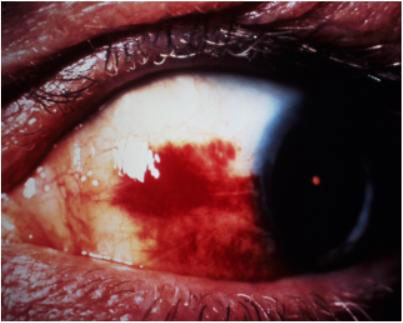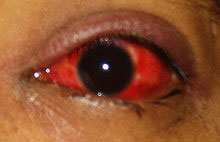Red eyes usually will cause us to be concerned that something is wrong with our eyes. In this condition we notice that our eyes become reddish. The surface of our eyes looked red because of swelling or dilatation of the blood vessels in the eye.
There are many conditions that cause our eyes to turn red.
Some of these causes could be :
- medical emergencies,
- need urgent medical attention
or - are not harmful
The degree of redness do not tell us how severe the problem us. Signs that point to how serious the condition is, are :
- blurring of vision
and or - whether there is pain
- pain when exposed to light ( photophobia)
Causes of non- painful red eyes
There are many causes of non- painful red eyes. Some of the common causes are :
- Subconjunctival haemorrhage
- Conjunctivitis
- Allergy
- Episcleritis
Subconjunctival haemorrhage

Subconjuctival haemorrhage is a condition when there is bleeding just below the conjunctiva. The conjunctiva is a thin transparent lining covering the white part of the eye and the inside of the eyelids.
There are nerves and many small blood vessels at the conjunctiva. These blood vessels may break easily as they are fragile.
What are the causes ?
Most of subconjuctival haemorrhage occur spontaneously without any obvious cause. You may wake in the morning and noticed a red spot at the white part of your eye. Sometimes you may not notice it but others may ask you why your eyes are red.
Some other causes that may cause subconjuctival haemorrhage are :
- sneezing
- coughing
- straining or vomiting
- rubbing the eyes
- injury
Treatment
Subconjunctival haemorrhage usually does not need any treatment. It will often resolve within 1 week. However if you notice a red spot in your eye, please see your doctor for it to be examined in order to come to a diagnosis.
Prevention
There are no known preventive measures.
Conjunctivitis

Conjunctivitis is a condition where there is inflammation of the conjunctiva. The conjunctiva is the outermost layer of the eye and the inner surface of the eyelids.
What are the causes?
It is most commonly caused by viral infections
Other causes include :
- bacterial infections
- allergy
- chemicals or other irritants exposures
- fungi
- some diseases like rheumatoid arthritis, Systemic Lupus erthrymatosis, ulcerative colitis, crohn’s diseases, kawasaki’s disease etc.
Bacterial and viral infections are contagious. They are usually passed from person-to-person, but can also spread when objects that are contaminated example towels or handkerchiefs are shared.
What are the symptoms and signs?
- Eyes will appear red. It usually starts with one eye and the other eye will be affected soon after.
- There will be discharge from the eyes and in the morning when you awake you may find crusts at the eyes.
- There is discomfort and irritation at the eye but it is not painful.
- There will be photophobia i.e. discomfort when looking at light or in bright areas.
- Vision is not usually affected but there may be complications.
Treatment
Treatment of conjunctivitis depends on the cause.
The treatment of conjunctivitis depends on the cause. When there is bacterial infection, antibiotic eye drops will be given. Viral conjunctivitis disappears on its own. Many doctors also give mild antibiotic drops to prevent bacterial infections.
If it is caused by allergens, anti- allergens will be given. Steps may be taken to identify the allergen and remove it from the surroundings of the affected person.
To soothe the eye from the discomfort of conjunctivitis, warm compresses may be applied to the closed eyes.
Prognosis
Prognosis is usually good with treatment
Prevention
Preventive measures are important to avoid reinfection or spread of infection to the household or school.
The best preventive measure is not to rub your eyes with your hands. Use a clean handkerchief or tissue paper.
Practise good hygiene:
- Wash your hands often.
- Keep hands away from the eyes.
- Do not share towels or handkerchiefs .
- Handle and clean contact lenses properly.
- Do not share eye cosmetics.
- Replace eye cosmetics regularly .
- Change pillow cases frequently.
When to seek help
If you notice that you have red eyes, please see your doctor to have a full examination and to receive proper treatment.
Allergic eye condition
Allergy is another common cause for non- painful red eye. You may have eye allergies if your eyes are red, itchy and or watery.
This condition can affect the eyes only but frequently there may also be associated nasal symptoms like sneezing, running or blocked nose.
What causes allergic eye condition?
It’s caused by allergens that are usually in the air. They come into contact with your eyes and nose and cause allergic reactions.
Examples of allergens that are airborne include :
- Dust
- Pollens
- Mould
- Pet dander
Other allergens include certain cosmetics or drugs like antibiotic eye drops.
What are symptoms and signs of allergic eye conditions?
Commonly the symptoms and signs are :
- Red eyes
- Itchy eyes
- Swelling of the eyes
- Watery eyes or discharge
Treatment
- Most allergic eye conditions are irritating but are usually not dangerous.
- Avoid the allergens that cause the allergic reaction to the eye.
- Flush eye thoroughly with luke warm water ( tap water) or use commercial preparation of eye wash. If symptoms do not recede or you suffer from worsening of symptoms, pain or blurring of vision after flushing please see your doctor for further treatment. Delaying treatment may lead to complications .
- Do not rub your eye. Rubbing usually will worsen the allergic response.
- Your doctor may prescribe topical anti-histamine preparations. Topical steroids are used with caution and under supervision of your ophthalmologist. Prolong use of topical steroids could lead to serious complications.
Prevention
- Try to stay away from the allergen.
- Keep your home clean and free of pet dander and dust.
- Do not allow your pets to be on your furniture.
- Even though rubbing your eye is a natural response when your eyes are itchy, remember rubbing will only make it worse. Do Not Rub Your Eyes.
Episcleritis
Episclera is a thin layer covering the white part of the eye. Episcleritis is a condition where there is irritation or inflammation to the episclera. It is quite a common condition.
What are the causes
The cause is unknown. It may occur with certain diseases like :
- Rheumatoid arthritis
- Herpes zoster
- Syphilis
- Tuberculosis
What are the symptoms?
It is usually a mild disease. Amongst the symptoms are :
- The eyes appear pinkish or reddish
- Mild to moderate eye discomfort ( may be painless)
- Photophobia ( light aggravates the symptoms )
- Watery discharge at eyes
Treatment
It is usually a self- limiting condition and symptoms usually disappear after 1 -2 weeks.
Treatment with corticosteroids eye-drops could relieve the symptoms faster. Remember corticosteroids eye drops must be used with the supervision of the doctor. it must be used as a long-term treatment.
When to seek help
If your eyes appear red, please see your doctor for a full examination in order to come to a diagnosis and obtain treatment.
| Last Reviewed | : | 28 August 2020 |
| Writer | : | Dr. Nazrila Hairizan bt. Nasir |
| Accreditor | : | Dr. Nik Rubiah bte. Nik Abdul Rashid |
| Reviewer | : | Dr. Nazhatussima bt. Suhaili |







